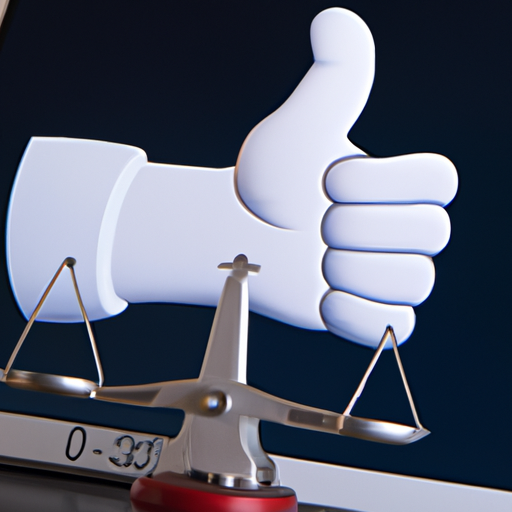In today’s digital age, social media has become a powerful platform for individuals to express their opinions, share their experiences, and influence the masses. With countless individuals vying for attention, one particular group has emerged as a force to be reckoned with – social media influencers. These individuals have amassed a substantial following and can sway public opinion, making them a sought-after marketing tool for brands and businesses. However, a recent wave of controversy surrounding the authenticity and ethics of these influencers’ claims has sparked a heated debate. This article will explore the world of social media influencers, their impact on consumer behavior, and the legal implications associated with their claims. As we delve into this complex subject matter, it is crucial to separate fact from fiction and understand the legal considerations at play.

The Rise of Social Media Influencers
Social media influencers have become a powerful force in today’s digital landscape. With the widespread use of social media platforms such as Instagram, YouTube, TikTok, and Twitter, individuals with large followings have the ability to sway public opinion and impact consumer behavior. These influencers, often known for their expertise in a particular niche, can build trust and credibility with their audience, making them valuable marketing assets for businesses.
Social media influencer trends
The rise of social media influencers can be attributed to several key trends. First, the increasing popularity of social media platforms has led to the rise of individuals who have amassed a significant following. These influencers have the ability to connect with their audience in an authentic and relatable way, creating a sense of trust and loyalty.
Additionally, the shift towards visual content, such as photos and videos, on social media platforms has provided influencers with a powerful tool to engage their audience. With the ability to create visually appealing and compelling content, influencers can capture the attention of their followers and influence their purchasing decisions.
Moreover, the rise of micro-influencers, who have a smaller but highly engaged following, has also contributed to the influence of social media influencers. These individuals often have a deep knowledge and passion for a specific niche, allowing them to connect with their audience on a more personal level.
Impact on marketing strategies
The emergence of social media influencers has forced businesses to reevaluate their marketing strategies. Traditional forms of advertising, such as television commercials and print ads, are no longer as effective in reaching and engaging consumers. As a result, companies are increasingly turning to influencers to promote their products or services.
Collaborating with influencers allows businesses to tap into their established audience and benefit from their trust and influence. By incorporating influencers into their marketing strategies, businesses can reach a wider audience, increase brand exposure, and potentially drive sales.
Influence on consumer behavior
One of the most significant impacts of social media influencers is their ability to shape consumer behavior. The recommendations and endorsements from influencers can have a profound effect on the purchasing decisions of their followers. A positive endorsement from an influencer can establish credibility, trust, and desirability for a product or service.
Influencers often provide honest reviews and recommendations based on their personal experiences, which resonates with their followers. This authenticity and relatability make influencers more convincing than traditional advertisements, leading consumers to trust their opinions and make informed purchasing decisions.
Legal Considerations for Social Media Influencers
While social media influencers have gained significant popularity, they also face a range of legal considerations that they must navigate. Ensuring compliance with the law is essential to protect both influencers and the businesses they collaborate with. Understanding the legal landscape can help influencers and businesses mitigate legal risks and ensure a successful collaboration.
Identifying sponsored content
One of the key legal considerations for social media influencers is properly identifying sponsored content. The Federal Trade Commission (FTC) requires influencers to disclose any material connections they have with the brands or products they promote. This includes receiving compensation, free products, or any other form of consideration.
Influencers must clearly disclose their relationship with the brand or product to their audience. This can be done through hashtags such as #ad, #sponsored, or #paidpartnership. Properly identifying sponsored content ensures transparency with the audience and compliance with FTC guidelines.
Disclosure requirements
In addition to identifying sponsored content, influencers must also comply with disclosure requirements set forth by the FTC. These requirements dictate the manner and clarity of disclosure to ensure that the audience understands the influencer’s relationship with the promoted brand or product.
Disclosures should be clear, conspicuous, and easily noticeable to the audience. They should be placed where users are likely to see them, such as within the first few lines of a caption, or at the beginning of a video. Failure to comply with disclosure requirements can lead to legal consequences and damage to the influencer’s reputation.
FTC guidelines
The FTC provides guidelines for influencers to ensure compliance with the law. These guidelines aim to protect consumers from deceptive or misleading advertising practices. Influencers must follow these guidelines to avoid legal ramifications and maintain their credibility.
The FTC emphasizes a need for truthfulness, transparency, and accountability in influencer marketing. Influencers must make honest and accurate claims about the products or services they promote. They must also disclose any material connections with the brands they collaborate with.
Intellectual Property Issues in Social Media Influencer Claims
Intellectual property issues are a common concern in social media influencer claims. Protecting intellectual property rights is crucial for both influencers and businesses to safeguard their brands and creative content.
Protecting your brand
Social media influencers should take steps to protect their personal brand and ensure that it does not infringe upon the rights of others. This involves conducting thorough research to ensure that the chosen name, logo, or image does not violate any existing trademarks or copyrights.
Registering trademarks for unique brand elements can provide legal protection and prevent others from misusing or infringing on the influencer’s intellectual property rights. Additionally, influencers should be vigilant in monitoring unauthorized use of their content and take appropriate action to address any infringements.
Copyright infringement
Social media influencers must be mindful of copyright laws when creating and sharing content. Copyright protects original works of authorship, including photos, videos, and written content. As such, influencers should obtain permission or a license when using copyrighted material owned by others.
Infringing on someone’s copyright can result in legal consequences, such as monetary damages and injunctions. Influencers should be aware of fair use exceptions, which allow limited use of copyrighted material for purposes such as criticism, commentary, or educational purposes. However, understanding the nuances of fair use can be complex, and seeking legal advice is advised.
Trademark violation
Influencers must also be cautious not to infringe on existing trademarks. Trademarks protect brand names, logos, slogans, and other distinctive elements that identify the source of goods or services. The unauthorized use of a trademark can lead to confusion among consumers and dilution of the trademark’s distinctiveness.
Influencers should conduct thorough searches to ensure that the names, logos, or slogans they intend to use do not infringe on any existing trademarks. Additionally, seeking legal guidance can help determine whether the intended use falls within the parameters of fair use or constitutes infringement.
Defamation and Privacy Concerns
Defamation and privacy issues are significant legal considerations for social media influencers. Understanding the boundaries and limitations can help influencers protect themselves from potential legal disputes.
Defamation in social media
Defamation occurs when false statements are made that harm the reputation of an individual or business. Social media influencers should be cautious when making statements about others, as false or defamatory statements can lead to legal consequences.
Influencers should verify the accuracy of the information they share and ensure that their statements are supported by facts. Opinion-based statements generally receive more legal protection, but even opinions can cross the line into defamation if they are presented as false statements of fact.
Invasion of privacy
Invasion of privacy is another concern for social media influencers. Privacy laws vary between jurisdictions, but influencers should be mindful of respecting the privacy rights of others. Sharing personal or private information without consent can lead to legal action.
Influencers should obtain consent when featuring individuals in their content or sharing personal information. Additionally, respecting the boundaries of private spaces and refraining from intrusive or unauthorized filming or recording is essential to avoid privacy violations.
Public vs private figures
The legal obligations and standards differ for public and private figures in defamation cases. Public figures, such as celebrities or politicians, typically have a higher burden of proof to establish defamation. They must prove that the defamatory statements were made with “actual malice,” meaning knowing falsity or reckless disregard for the truth.
In contrast, private figures have a lower burden of proof and generally do not need to prove actual malice. However, the specific legal standards can vary depending on the jurisdiction. Influencers should seek legal advice to understand the defamation laws in their respective jurisdictions.
Contractual Agreements in Influencer Marketing
Contractual agreements are an integral aspect of influencer marketing collaborations. Clear and well-drafted contracts help establish the rights, obligations, and expectations of both the influencer and the brand. Having a solid contractual foundation can help prevent disputes and ensure a successful partnership.
Negotiating influencer contracts
When entering into an influencer marketing collaboration, both parties should negotiate and agree upon the terms and conditions of the agreement. Influencers should consider factors such as compensation, content creation guidelines, exclusivity clauses, and the duration of the collaboration.
Brands, on the other hand, may include provisions related to disclosure requirements, usage rights, performance metrics, and deliverables. Negotiating these terms allows both parties to reach a mutually beneficial arrangement and ensures that the expectations of both parties are clear and defined.
Performance obligations
Influencer contracts should clearly outline the performance obligations of the influencer. This includes the type and quantity of content to be created, the frequency of posting, and any specific messaging or themes to be incorporated.
Additionally, contracts often specify performance metrics, such as engagement rates or reach, that the influencer must achieve. Establishing clear performance obligations helps ensure that the influencer meets the brand’s expectations and provides a consistent level of quality content.
Payment terms
Payment terms are a crucial aspect of influencer contracts. Influencers should clearly state their compensation requirements, whether it be a flat fee, a percentage of sales, or a combination of both. Ideally, payment terms should be agreed upon before the collaboration begins to avoid disputes or delays.
Contracts may include provisions related to the timing and method of payment, such as invoicing requirements or installment payments. It is essential for influencers to keep track of their performance and ensure that they receive the agreed-upon compensation in a timely manner.
Strategies to Mitigate Legal Risks
To mitigate legal risks, social media influencers and businesses should adopt specific strategies and best practices. Being proactive and implementing compliance measures can help prevent legal disputes and maintain the integrity of influencer marketing collaborations.
Building a compliant social media strategy
Having a compliant social media strategy is crucial for both influencers and businesses. This involves understanding and adhering to the legal requirements, such as FTC guidelines and disclosure requirements. Influencers should clearly disclose their relationships with brands and ensure that their content is truthful and accurate.
Brands should establish guidelines and monitor the content created by influencers to ensure compliance with legal obligations. Clearly communicating these expectations to influencer partners and providing them with the necessary resources can prevent legal issues from arising.
Monitoring and enforcing rights
Monitoring the unauthorized use of intellectual property and content is essential to protect the rights of influencers and businesses. Regularly monitoring social media platforms, websites, and other online channels can help identify potential infringements or misuse of content.
Influencers and brands should be prepared to take appropriate action in response to any infringements. This may include issuing cease-and-desist letters, sending takedown notices, or pursuing legal action. Being proactive in enforcing intellectual property rights strengthens the legal position of influencers and businesses.
Responding to legal threats
In the event of receiving legal threats, influencers and businesses should handle them diligently and seek appropriate legal advice. It is crucial to respond in a timely manner and assess the validity of the claims made against them.
Depending on the nature and severity of the legal threat, a range of actions can be taken. This may involve negotiating a resolution, providing evidence to refute the claims, or engaging in alternative dispute resolution mechanisms such as mediation or arbitration.

Dealing with Content Removal and Takedown Requests
Content removal and takedown requests are common issues faced by social media influencers. Understanding the legal framework surrounding content removal requests can help influencers navigate these situations effectively.
Understanding DMCA notices
The Digital Millennium Copyright Act (DMCA) provides a mechanism for copyright owners to request the removal of infringing content from online platforms. Influencers may receive DMCA notices if they have inadvertently used copyrighted material without permission.
Understanding how to respond to DMCA notices is crucial for influencers. This generally involves removing the infringing content or disputing the notice if there are valid defenses, such as fair use. Properly addressing DMCA notices demonstrates compliance with copyright laws and helps maintain positive relationships with platform providers.
Responding to copyright claims
In the event of receiving a copyright claim, influencers should carefully assess the validity of the claim. This involves determining whether the material in question is subject to copyright protection, and whether the use falls within the scope of fair use or other applicable exceptions.
If the claim is valid, influencers should promptly respond by removing or modifying the infringing content. Negotiating a resolution, such as obtaining a license or permission to use the copyrighted material, can sometimes be an effective way to address copyright claims.
Challenging false removal requests
In some cases, influencers may receive false or improper takedown requests. These requests may be made in an attempt to stifle criticism, suppress speech, or manipulate the digital landscape. Influencers should be aware of their rights and have mechanisms in place to challenge false removal requests.
Platform providers often have procedures for filing counter-notices to challenge a takedown request. Understanding these procedures and providing appropriate evidence to support the counter-notice can help influencers reinstate content that has been improperly removed.
Disputes and Resolution Mechanisms
In the event of a legal dispute, there are various mechanisms available to resolve conflicts. It is advisable to explore alternative dispute resolution options before resorting to litigation, as these methods can often be more efficient and cost-effective.
Mediation and negotiation
Mediation and negotiation are forms of alternative dispute resolution that allow parties to resolve conflicts through dialogue and compromise. In these processes, a neutral third party facilitates discussions and assists the parties in reaching a mutually acceptable resolution.
Mediation and negotiation offer benefits such as flexibility, confidentiality, and the opportunity to maintain business relationships. They provide an opportunity for influencers and businesses to work out their differences without the need for formal litigation.
Arbitration agreements
Arbitration is another form of alternative dispute resolution that is binding on the parties involved. By entering into an arbitration agreement, parties agree to submit their dispute to an arbitrator or panel of arbitrators who will make a binding decision. Arbitration can provide a quicker and more efficient resolution compared to the traditional court system.
Including arbitration clauses in influencer contracts can help expedite dispute resolution and potentially reduce costs associated with litigation. However, it is essential to carefully review the terms and conditions of arbitration agreements and consider the potential benefits and drawbacks.
Litigation as a last resort
Litigation should be considered as a last resort when all other dispute resolution methods have been exhausted. Legal action can be time-consuming, expensive, and potentially damaging to the reputation of both influencers and businesses.
However, in some cases, litigation may be necessary to protect rights or enforce contractual obligations. When contemplating litigation, influencers and businesses should consult with experienced legal counsel who can assess the strengths and weaknesses of the case and guide them through the legal process.

Social Media Influencers and Employment Law
The relationship between social media influencers and businesses often raises questions about employment law and worker classification. Clarifying the relationship and ensuring compliance with employment laws is crucial to prevent potential legal disputes.
Worker classification issues
Determining the worker classification of social media influencers is complex. Influencers can fall into different categories, such as independent contractors or employees, depending on various factors. These factors include the degree of control exercised by the business, the level of independence of the influencer, and the nature of the working relationship.
Misclassifying influencers can have legal and financial consequences, including liability for unpaid wages, overtime, and employment-related benefits. It is essential for businesses to carefully evaluate the worker classification of influencers to ensure compliance with employment laws.
Ensuring compliance with employment laws
Businesses should familiarize themselves with the employment laws that govern influencer relationships within their jurisdiction. This includes laws related to minimum wage, overtime, employment taxes, workers’ compensation, and anti-discrimination.
Considering the legal implications, businesses should establish clear guidelines and expectations for influencers to ensure compliance with employment laws. This may include providing guidance on working hours, specific performance requirements, and scope of work. It is essential to consult with legal professionals to ensure full compliance with applicable employment laws.
Contractual disputes with influencers
Disputes related to contracts and agreements can arise between social media influencers and businesses. These disputes may involve issues such as payment disputes, scope of work disagreements, or alleged breaches of contract.
To prevent or address contractual disputes, it is crucial to have well-drafted agreements that clearly specify the rights, obligations, and expectations of both parties. These agreements should address potential areas of contention, such as termination clauses, dispute resolution mechanisms, and remedies for breach of contract.
FAQs about Social Media Influencer Claims
What legal obligations do social media influencers have?
Social media influencers have several legal obligations to consider. They must comply with FTC guidelines, properly disclose sponsored content, and respect intellectual property rights. Additionally, influencers should avoid making false or defamatory statements and protect the privacy rights of others.
How can businesses protect themselves against influencer claims?
To protect against influencer claims, businesses should implement clear contractual agreements that outline the rights, obligations, and expectations of both parties. Monitoring content created by influencers and enforcing intellectual property rights are also essential. It is advisable to work closely with legal professionals to navigate potential legal risks effectively.
Can social media influencers be sued for defamation?
Yes, social media influencers can be sued for defamation if they make false statements that harm the reputation of an individual or business. It is important for influencers to ensure the accuracy of the information they share and rely on facts rather than making false claims.
What happens if an influencer violates FTC guidelines?
If an influencer violates FTC guidelines, they may face legal consequences and damage to their reputation. The FTC can initiate enforcement actions, issue fines, and require compliance measures. It is essential for influencers to properly disclose their relationships with brands and adhere to the guidelines to maintain credibility and legality.
Are there any recent legal cases involving social media influencers?
Yes, there have been numerous legal cases involving social media influencers in recent years. These cases have covered a range of issues, including disclosure violations, intellectual property disputes, and defamation claims. Staying informed about recent cases helps influencers and businesses understand the legal landscape and make informed decisions.
In conclusion, social media influencers have transformed the marketing landscape and possess the power to influence consumer behavior. However, navigating the legal considerations surrounding influencer claims is crucial for both influencers and businesses. By understanding their legal obligations, protecting intellectual property rights, and respecting defamation and privacy concerns, influencers and businesses can collaborate effectively while mitigating potential legal risks. Employing well-drafted contractual agreements, adopting compliance strategies, and exploring alternative dispute resolution mechanisms can further contribute to a successful influencer marketing partnership.




































